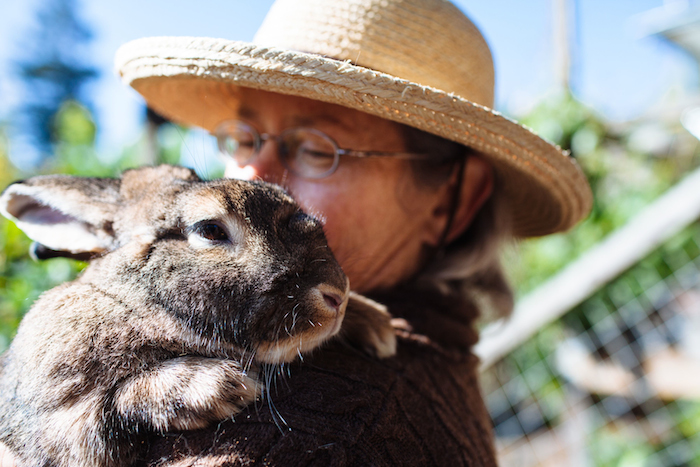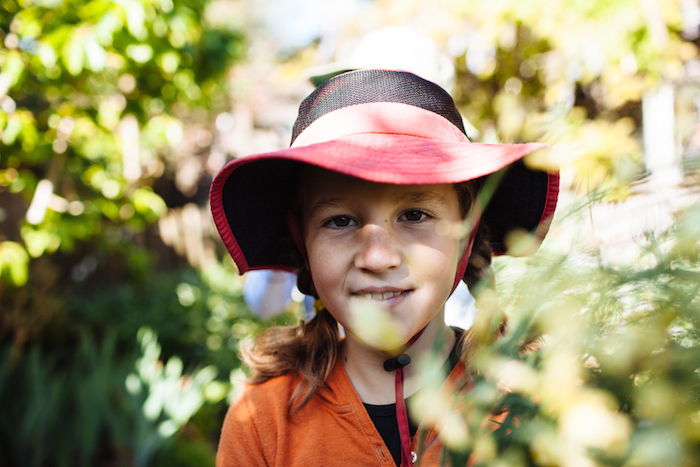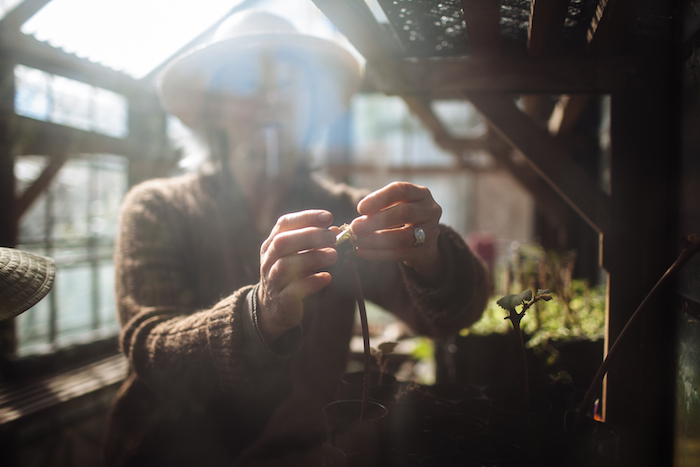A food forest grows at Chickweed Patch in Petaluma.
Suzanne Mackey leads the way through a berry bush-lined path of her backyard, next to a greenhouse made entirely of recycled materials. The berries aren’t yet ripe, but the scene is like something out of a fairytale—especially for me, a born-and-bred Los Angeles kid who fell in love with Sonoma County after picking sun-warmed blackberries on a ridge in Occidental 20 years ago. Mackey, a naturalist and part-time school garden coordinator, touches the leaf of a thornless blackberry, a hybrid developed by Luther Burbank.
“They say he talked the blackberry into letting go of its thorns by convincing the plant it was safe and didn’t need to be on the defense,” Mackey says with an easy smile. It’s a moment of magical realism that adds a perfect touch to a day spent at Chickweed Patch, Mackey’s urban homestead with a permaculture twist, located just a five-minute walk from downtown Petaluma.
Here on a 6,000-square-foot lot, Mackey and her husband Paul have implemented permaculture principles to transform their urban property into a remarkably beautiful and abundant place. There’s a high-functioning rainwater catchment system that can store up to 3,000 gallons of rainwater. (The tanks drain into a duck pond where live fish fertilize the water.) Plus, Mackey has done extensive remediation, amending, and improving the health of the property’s clay soil through compost and a near-religious devotion to mulching.
One of the most widely referenced books on permaculture is Gaia’s Garden by local author Toby Hemenway. Hemenway explains the word as a contraction of “permanent agriculture” and “permanent culture.” First coined by Bill Mollison, an Australian forester and field naturalist, the term permaculture describes a system of regenerative design, a set of principles and practices used to create ecologically minded and sustainable human settlements that work with nature. It’s not just about gardening and growing food, it’s about making connections between organic gardening, renewable energy, zero waste, soil-building, social justice, recycling, and consensus decision making to transform homes, neighborhoods, communities, and even entire societies.
Mackey got bit by the bug while visiting a college friend who lived at the Occidental Arts and Ecology Center, a home for permaculture in the heart of West County. “My mind was blown by the abundance around me,” Mackey told me. “It looked more like a forest than an orchard or a garden. Flowers everywhere, bees buzzing, berries growing under the tree canopy.”
Nearly a decade ago, Mackey signed up for a Permaculture Design Certificate Course at the Regenerative Design Institute in Bolinas. She and a friend who had bought the house adjoining Mackey’s backyard attended sessions led by renowned teacher Penny Livingston-Stark with Erik Ohlsen of Permaculture Artisans in Sebastopol. Over the course of nine months, they learned about biodiversity, food forests, water catchment, grey water systems, honeybees, backyard livestock, soil, waste reduction, and how this might all work within a closed system.
The transformation of Mackey’s 1907 home began in 2006. First, she practiced observation. Where were the wettest spots? The sunniest spots? What did the site provide already? What was growing well? Where might deciduous trees be happiest? How about frost-hating citrus trees? What materials could be recycled into a better end-use?
At the time, the couple had already begun trucking in piles of compost, trying to make a gravel driveway populated with a few climbing roses and a small oak tree into a place for food production. But Mackey really made the connection to what she was learning in her sessions on the day she came home to find Paul building a drain system that would direct rainwater away from their property. Like most people, he viewed the excess water as a problem, particularly since the water jetted straight down the slanted driveway, taking topsoil with it, and flowing right into a neighbor’s yard and basement.
“I had just learned about water catchment, and I was like, no!” says Mackey. “We need to slow it, sink it, and spread it.” This is a great representation of a key permaculture principle: The solution is in the problem. The former gravel driveway is now a marvel of soil contouring—”swales,” “berms,” and “keyholes” in permaculture parlance. The water gets directed towards the plants, ensuring that they receive the right amount of water.
“Instead of seeing the rain coming off of your roofs and rushing down the street as a problem, we turn it into a solution and we catch it,” Mackey says. “And of course, building the soil is also conserving water. Which is important, especially in these times.”
Right now, Mackey’s food forest is at the tail end of its winter state. You’d think it would be half-dormant and wilted, but life is everywhere. Butterflies descend into borage flowers; kale and chard spring out of mounds of compost covered in straw. The arugula has gone to flower, along with the cilantro.
“Try it,” Mackey says, pointing at the delicate white flowers. I hesitate and then take a nibble. The taste is lovely, a muted version of cilantro’s high kick. Mackey loves for people to sample whatever they see in the garden, whether they be the stone fruits growing in the height of summer or wild plums, cherries and apples, figs and cilantro, little pieces of lettuce or chard, or one of the borage flowers popping up here and there.
“Just like in a real forest, you don’t walk in straight lines,” Mackey says. “You might go over to a tree and smell it, and cross over to another plant and pick a little leaf. Plants grow right where they get what they need. There is no uncovered soil. That’s exactly how our gardens should be for building and protecting the soil, and for water conservation. It’s a no-brainer.”
Mackey is so passionate about the transformation of her backyard that she opens it up for summer camps, where neighborhood kids make natural dyes, learn about medicinal herbs, forage apples for cider, turn the compost bins, and hang out with the ducks, chickens, fish, and rabbits.
In a video about his “Greening the Desert” project, urban permaculture teacher Geoff Lawton says: “You can solve all the world’s problems in a garden.” Lawton is onto something. A strategically planned food forest can help mitigate not just soil erosion, but greenhouse gas emissions and water waste, all while producing vegetables and fruit for the dinner table. Visiting Mackey’s urban homestead makes Lawton’s vision seem attainable. For in this backyard paradise, where pollinators always have something to forage and fruits, vegetables, and animals are given the right conditions to thrive, you can see how the world might be if we placed a higher value on the natural world and aspired to wealth that can’t be measured by the GNP.
Just like in a real forest, you don’t walk in straight lines. ~Suzanne Mackey
“A lot of kids and their parents come through here and get inspired by the systems,” Mackey says. “The abundance of a permaculture food forest, urban or otherwise, is mind-blowing—and they want it. It’s like walking into a forest. Forests are abundant with insects, birds, food, medicine, shelter, forage, firewood, everything. All of that can be replicated in a pretty small space and that’s what we’re doing here.”



